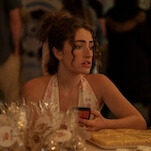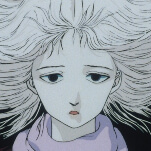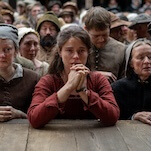Each week, Big Issues focuses on newly released comic books of significance. This week, they are Agents Of The Realm by Mildred Louis and M.F.K. by Nilah Magruder, two online series that showcase the outstanding work being done by black women cartoonists in webcomics. (Note: This review reveals major plot points.)
In January of last year, Miz Caramel Vixen, co-creator of the multidisciplinary website Vixen Varsity, launched #BlackComicsMonth, a Twitter hashtag dedicated to spotlighting black comics creators over the course of Black History Month in February. The hashtag quickly caught on with the larger comics community, spawning a website that continues to shine that spotlight year-round, proudly proclaiming that “Every Month is BlackComicsMonth!” (For more on the creation of #BlackComicsMonth, check out this A.V. Club interview with Miz Caramel Vixen.) The hashtag and its creator are doing important work expanding awareness of black creators in an industry dominated by white men. All it takes is one review of this week’s new releases to see how sorely lacking comics are in representation off the page.
Looking at publishers Marvel, DC, Image, Dark Horse, Valiant, Boom!, and Dynamite, there are six black creators with new material hitting stands this week: David Walker (writer) and Sanford Greene (artist) on Marvel’s Power Man & Iron Fist #1, Dominike “Domo” Stanton (artist) on Marvel’s Starbrand And Nightmask #3, Valentine De Landro (artist) on Bitch Planet #7, Khari Evans (artist) on Valiant’s Imperium #13, and Jerry Gaylord (artist) on Bill & Ted’s Most Triumphant Return. That number on its own is sad, but it’s even worse considering all of these names are men, and only one of them is in a writer position, which is the role more heavily valued in the current comics landscape.
Black women have historically been underrepresented both on and off the page in comics, and while there have recently been some positive changes, progress is still moving very, very slowly. It’s been wonderful seeing artists Brittney Williams and Natacha Bustos (who is half Afro-Brazilian and half Chilean) on Marvel’s Patsy Walker, A.K.A. Hellcat! and Moon Girl & Devil Dinosaur, respectively, but again, they’re limited to the artist’s role, realizing the scripts of white writers but not getting the opportunity to tell their own stories. Black women readers yearning for better representation don’t have many options in print comics, but they can find a wealth of riches in the world of webcomics, where there’s a steadily growing community of black women cartoonists creating exceptional comics that should be garnering the attention of major publishers.
In last week’s Big Issues on Gotham Academy, I wrote about how superhero companies in particular could greatly benefit from reaching out to new talent, and if editors are looking for exciting new voices, they can start by looking at webcomics like Mildred Louis’ Agents Of The Realm and Nilah Magruder’s M.F.K., which balance fantastic story elements with rich character development. Agents Of The Realm has new pages up twice a week on Tuesdays and Thursdays. This week features two pages that highlight the fantasy aspect of the narrative as they show the vibrant transformation of five young women into interdimensional warriors. Louis also launched a Kickstarter this month for a softcover print collection of the title’s first volume, which was fully funded in a week and is currently nearing its second Stretch Goal.
A magical girl ongoing series inspired by manga like Sailor Moon and Magic Knight Rayearth, Agents Of The Realm features a lot of familiar fantasy elements, but it ties them to a story rooted in personal experiences that aren’t as prevalent in the genre: those of young adult women of color. The main cast of five agents is predominantly black, with one Latina and one white woman, and they cover a variety of sexual orientations that are each depicted casually in the script. Queer is totally normal in Louis’ narrative, and she never has any of the characters explicitly state their sexual orientation because it’s not a distinction that needs to be made. Characters simply show their attraction to others, and while some of the Agents focus solely on other women, some of them have also expressed a romantic interest in men.
The current “Chapter 5” is a prime example of Louis’ approach to sexuality, with the Agents pairing up with potential love interests at a Halloween dance on their college campus. Held back by her shyness and awkwardness around strangers, main character Norah Tanner has the most trouble in this regard. She tries to start up a conversation with a woman dressed as Snow White while waiting for a bottle of water, but Norah is flatly ignored. It could be easily interpreted as Norah wanting to start a friendly chat, but her expressions and body language suggest a deeper attraction that is confirmed during her exchange with the R.A. handing out water. Later in the chapter, Norah finally makes the personal connection she’s looking for when she meets a guy dressed as Sailor Moon’s Tuxedo Mask while sitting outside the men’s bathroom. But before she can pursue this opportunity any further, she and her fellow Agents are called into action.
Louis’ skills as both a writer and artist have gotten sharper over the two years she’s been working on Agents Of The Realm, and “Chapter 5” has been especially impressive, adding considerable definition to the character relationships and using the Halloween theme to deliver vivid, colorful visuals without tapping into the fantasy elements. This chapter reads more like Giant Days than Sailor Moon, and Louis’ talent for building captivating interpersonal relationships while working within a fantastic concept makes her a creator that should be on the radar of superhero comic editors.
M.F.K. has a much more sporadic release schedule due to Nilah Magruder’s outside work in animation and children’s books, and while there’s no new page this week, now is a good time to check out the work by last year’s recipient of the first-ever Dwayne McDuffie Award For Diversity, an award honoring the legacy of a writer/editor/producer who was a major advocate for diverse representation in comics and animation. (2016’s winner will be named at Long Beach Comic-Con this weekend.) It’s a shame that Magruder’s recognition hasn’t motivated any publishers to pick up M.F.K. for print. But given the craft on display in these pages, hopefully it’s just a matter of time before Magruder’s series makes the jump, ideally at a graphic novel publisher like First Second or Scholastic’s Graphix.
Set in a fantasy world with a broken government and corrupt peacekeeping force, M.F.K. blends social commentary with mystical elements to tell the story of a hearing-impaired girl with extraordinary abilities on a mission to scatter her mother’s ashes. The adventure depicted with an art style and design sensibility reminiscent of Avatar: The Last Airbender and The Legend Of Korra. Magruder’s experience in animation has made her visual storytelling remarkably clear; whether she’s rendering atmospheric environmental shots, hard-hitting action, or quiet character moments, everything is brought to the page with precision and care. This gorgeous title has only gotten more detailed as the cartoonist evolves, and while the wait between pages can be rough, the finished product is always worth it.
Magruder has been gradually building her story for the last four years, and while the series hasn’t covered much ground in terms of the larger narrative, the extended time spent laying the foundation has allowed her to smoothly establish the characters, settings, and mythology that make M.F.K. so engaging. Magruder primarily aimed to create a strong sense of place and develop the relationships between Abbie and the family that takes her in after she collapses in the desert. After giving the reader a firm handle on those elements, Magruder then started to delve further into the mythology of this foreign world.
It’s entirely possible that Magruder’s non-comics priorities prevent her from taking on projects at the major print publishers, and she may not have an interest in working on Marvel or DC superheroes, but has anyone reached out and asked? It generally takes considerably less time to write a script than it does to draw it (and color and letter it, which she also does on her own), so perhaps Magruder would be interested in writing for another artist. The same goes for Mildred Louis, who is handling all aspects of production for Agents Of The Realm on her own and doing a damn good job while sticking to a schedule. These cartoonists are putting so much work into their personal projects, they’ve proven that they have what it takes to handle higher profile work.
Agents Of The Realm and M.F.K. aren’t the only webcomics written and drawn by black women that are worth checking out: Gisele Jobateh’s Star Trip is a long-running intergalactic sci-fi series with an ensemble of multifaceted characters and sleek, imaginative visuals. Myisha Haynes’ The Substitutes is still in its early stages, but it’s a lushly illustrated fantasy yarn with a compelling mythology and striking design work. Like Agents Of The Realm, Shauna J. Grant’s Princess Love Pon! is another magical girl series with an even stronger Sailor Moon influence, and its chibi art style makes it a great book for younger readers.
Gyimah Gariba’s Nibi doesn’t have much of a story at this point, but it’s an intriguing abstract work that spotlights Gariba’s subtle, nonverbal characterization and evocative use of light and dark elements on the page. Readers that want more grounded stories should seek out Olivia Stephens’ Alone, a character-driven drama about the budding romance between a coffeeshop owner and the widower who owns the diner next door (you can find a review of Alone in next week’s Comics Panel), and the works of Shannon Wright, who doesn’t have an ongoing series, but creates powerful, personal comics on her Tumblr.
These are just some of the creators and projects out there, and there are more springing up all the time. It would be nice if all this effort from black women cartoonists led to work at bigger publishers, which offers the funds and industry exposure that webcomics do not. This Comics Alliance interview with webcomics pioneer C. Spike Trotman offers a lot of insight into the dismaying financial reality of creating webcomics. While there have been creators who have successfully jumped from independent webcomics to more lucrative comics work, these opportunities are rarely offered to black women. It’s time to change that, because the comics industry will never reach its full potential if it continues to ignore these bold creative voices.








































